PETER CROSS
(c.1645-1724)Portrait miniature of James Scott (formerly Crofts), Duke of Monmouth and first duke of Buccleuch (1649–1685)
Circa 1681-84
Watercolour on parchment
Later turned wood frame
Oval, 90 mm (3 ¹/₂ inches) high
SOLD
After a short spell in Holland, he returned to England but every effort to reconcile with his father failed. This portrait was likely painted at some point in the following few years, along with others by Peter Crosse. For example, another portrait by Crosse, painted a few years earlier in 1681, shows the Duke in similar costume, wearing armour, a lace cravat and the sash of the Garter.[1] This miniature, and others painted during the early years of the 1680s, may have been presented to Monmouth’s supporters as he attempted to promote himself as the legitimate, and Protestant, rightful heir to the English throne.[2] Interestingly, this miniature would appear to relate closely to a 1684 plumbago by James White (1645-1703), which may have been intended for engraving and further dissemination of Monmouth’s image.
In 1683, when the Rye House plot was discovered, James was found guilty of treason and conspiring to assassinate both the King and his uncle, the Duke of York. He was later granted a pardon by Charles, after agreeing to provide the names of his confederates. He lived again in Holland until Charles II's death in 1685 prompted his return to England and the Monmouth Rebellion.
Monmouth boldly (but foolishly) landed at Lyme Regis on 11th June that year and was proclaimed King at Taunton. Following his defeat at Sedgemoor by Royal troops on 5th July, James fled, disguised as a peasant. His capture and incarceration in the Tower swiftly followed before his execution on Tower Hill just ten days later.
Peter Crosse was a trusted court artist for Monmouth’s uncle Charles II and had been close to the internationally renowned limner Samuel Cooper. Crosse worked in a very different technique to Cooper. As the entry by John Murdoch in the ODNB notes, ‘the stipple is larger, softer, and more sombre, the head emerging from the dark background with a blurred silhouette and the face simplified in its structure and strongly lit from the front’.
[1] Sold Sotheby’s, 06 December 2018, lot 26.
[2] Another similar miniature, although slightly reversed in terms of the light source on the sitter’s armour, was signed and dated 1681 by Peter Crosse and sold Bonhams, 12th July 1993, lot 280. Welbeck Abbey also houses another miniature by Crosse of the same subject, dated 1681, proving that several miniatures were commissioned by court artists over this span of years.

shipping notice
Worldwide shipping is included in all prices.
The Limner Company does not accept any responsibility for import duty, this is to be paid by the buyer.
Some stock items contain materials from endangered species which are governed by CITES regulations and will require a permit to export outside of Great Britain. If a certificate of export is required then this will be the responsibility of and paid for by the buyer .
you may also like













